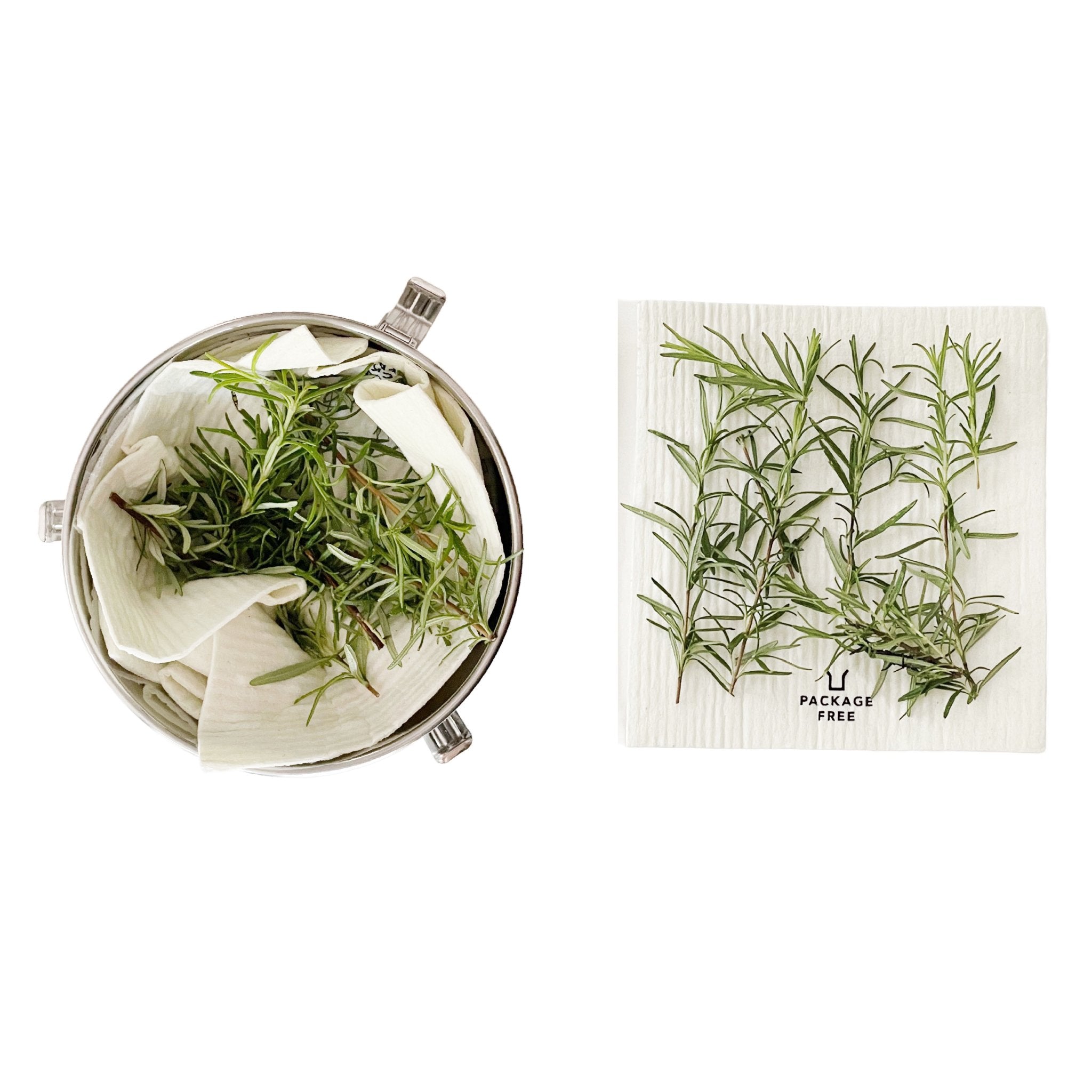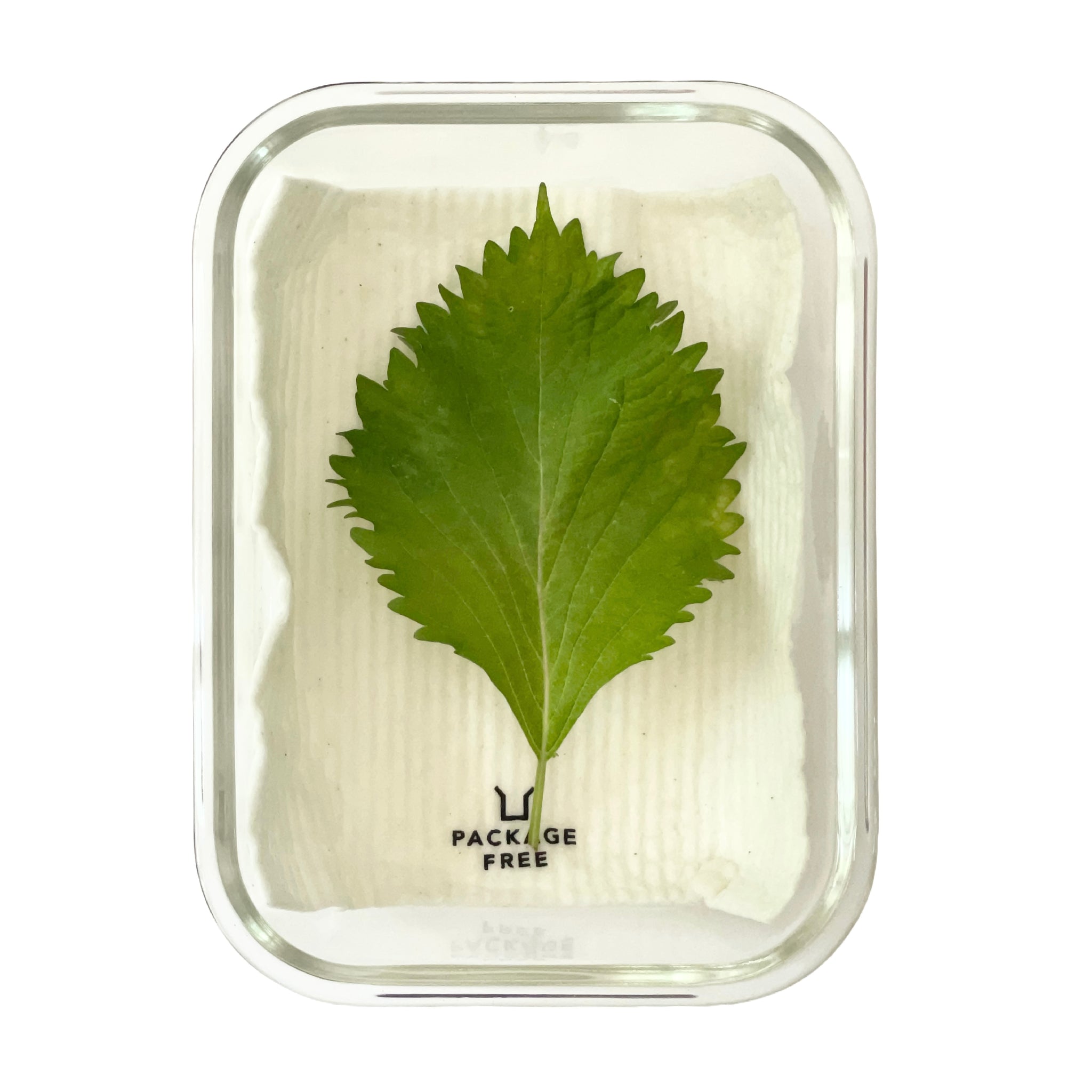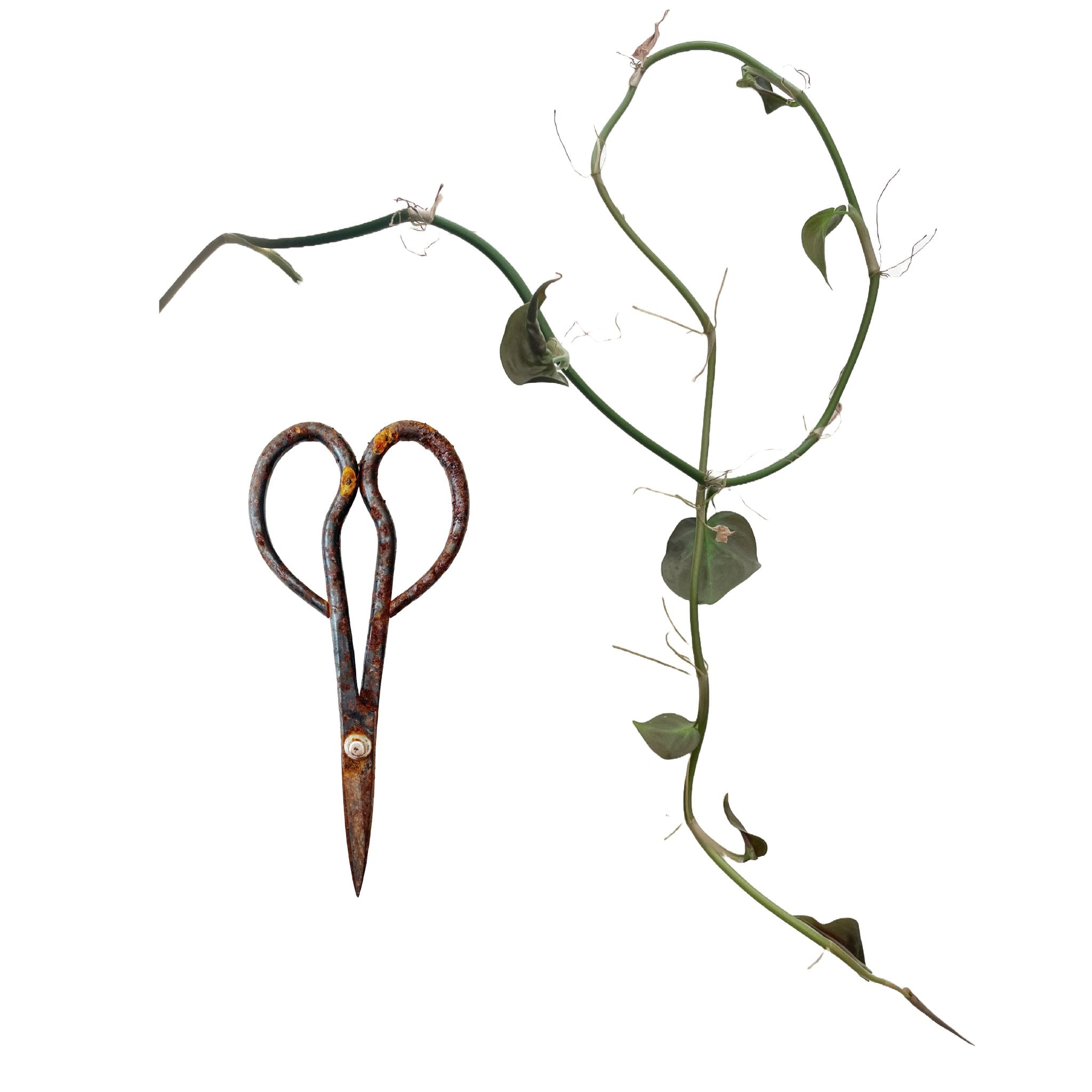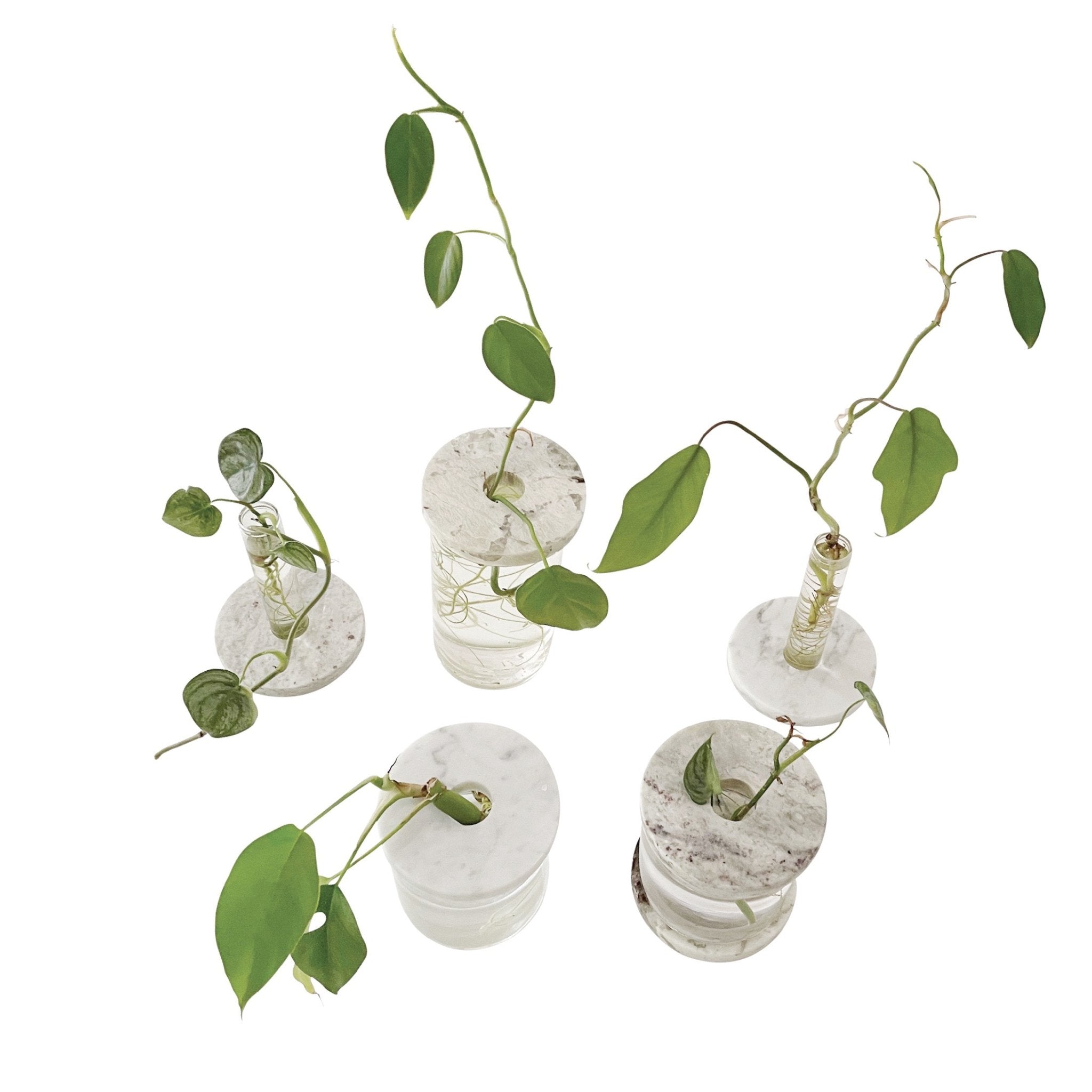STORE FRESH HERBS (ECO-FRIENDLY!)

ECO FRIENDLY HERB STORAGE
This is a step by step + eco-friendly guide on several different methods that can be used for storing fresh herbs. These methods focus on using more sustainable materials compared to traditional storage methods - such as storing herbs in a single use plastic produce bag or plastic tupperware. (HINT: NO plastic is used in these methods!)
We've ranked each method in descending order from longest --> shortest time of freshness.
- STEEL
- SILICONE
- GLASS
- CLOTH
Length of freshness time will vary by each herb type. But in general, hardy herbs will store better for longer periods of time when compared to soft herbs. Hard herbs are generally herbs that have a more woodsy stem and harder leaves. Soft herbs would generally be any herbs with softer stems and more tender leaves.
HARD HERBS: Rosemary, Thyme, Sage, Oregano, Lavender, Tarragon, Marjoram, Sweet Bay
SOFT HERBS: Basil, Parsley, Cilantro, Mint, Chives, Dill, Lemon Balm, Shiso
BENEFITS of using eco-friendly storage:
- Reduces waste (re-usable materials or materials that are recyclable/biodegradable)
- Saves money (re-purposing materials you already have)
- Reducing plastic consumption (huge pollution contributor)
- can re-use or re-purpose containers over and over
Method details and examples included below!
(1) STAINLESS STEEL CONTAINER

We found that the airtight stainless steel container is great for keeping herbs fresh in the fridge for 2-3 weeks!
Stainless Steel is a great green material as it is 100% recyclable. Additionally, steel is very durable, lightweight and easy to clean.
Time
Prep Time: 5 min
Time to use: use within 2-3 weeks
Materials
- STAINLESS STEEL CONTAINER - We are using our PACKAGE FREE AIRTIGHT STAINLESS STEEL CONTAINER in size 14cm. (use code RT1HOME at checkout for 10% OFF your order)
- FRESH HERBS OF CHOICE - We are using our ROSEMARY grown at home in a container. Alternatively, you can buy at the store.
- CLOTH - to wrap herbs inside container. We are using our PACKAGE FREE REUSABLE SWEDISH DISHCLOTH (compostable!) (use code RT1HOME at checkout for 10% OFF your order)
- WATER - to wash your fresh herbs
- SCISSORS / SNIPS (optional) - to harvest and to trim herbs for storage. We are using our GARDEN SNIPS
- WRITING TOOL (optional) - We are using our WAX PENCIL to label and date

Instructions
1. Gather FRESH HERBS OF CHOICE - either harvest your own with your SCISSORS/SNIPS. Or buy from your local grocery store. We are using Fresh Rosemary grown at home in a container.
2. Trim herbs as needed with your SCISSORS/SNIPS, remove any brown or damaged leaves.
3. Wash / soak FRESH HERBS room temperature tap WATER.
4. Place washed FRESH HERBS on your CLOTH and gently remove any excess WATER.
5. Spread herbs out as a thin layer on the CLOTH and repeat as needed
6. Place each CLOTH with FRESH HERBS inside the STAINLESS STEEL CONTAINER and gently stack layers.
7. Close and label the herb name and date with your WAX PENCIL on the container. ***This is optional but I have found it to be so helpful to remember how old the herbs are!
8. Store in the fridge for up to 2-3 weeks (pending herb type used).

(2) SILICONE
![]()
Silicone is a better material option than plastic as it is more durable, reusable, and recyclable. It also does not contain harmful chemicals such as BPA found in most plastics. Silicone is made from Silica - which is derived from sand. Sand is not an unlimited resource, but it is more abundant. The manufacturing process of Silicone does not involve the mining of crude oil - which is how most plastics are made.
The downside of Silicone is that it is not biodegradable, and needs to be taken to a special facility to be recycled (you cannot just throw in your household recycling bin).
Stasher partners with Terracycle which allows you to send your damaged or stasher bags that have reached their end of life. It is completely free and they provide you a free shipping label to ship directly to them and recycle.
Time
Prep Time: 5 min
Materials
- REUSABLE SILICONE BAG - to store fresh herbs. We are using our PACKAGE FREE Silicone Stasher bag in the half gallon size (8.5"W x 10.25"L). Stasher bags are made using Food Grade Silicone! (use code RT1HOME at checkout for 10% OFF your order)
- FRESH HERBS OF CHOICE - We are using our PEPPERMINT grown from seed from our TEA HERB SEED PACK
- CLOTH - to wrap herbs inside container. We are using our PACKAGE FREE REUSABLE SWEDISH DISHCLOTH (compostable!) (use code RT1HOME at checkout for 10% OFF your order)
- WATER - to wash your fresh herbs
- SCISSORS / SNIPS (optional) - to harvest and to trim herbs for storage. We are using our GARDEN SNIPS
- WRITING TOOL (optional) - We are using our WAX PENCIL to label and date

Instructions
1. Gather FRESH HERBS OF CHOICE - either harvest your own with your SCISSORS/SNIPS. Or buy from your local grocery store. We are using Fresh Peppermint grown at home in a container.
2. Trim herbs as needed with your SCISSORS/SNIPS, remove any brown or damaged leaves.
3. Remove lower leaves from the bottom few inches of the stems (use or compost them!)
4. Add WATER to your CLOTH so that it is damp, not soaked.
5. Gently roll herbs with bottom stems on top of the damp CLOTH and fully wrap. Secure wrap with your RUBBER BAND / TIE.
6. Place your wrapped FRESH HERBS inside the SILICONE BAG and seal closed.
7. Label the herb name and date with your WAX PENCIL on the container. ***This is optional but I have found it to be so helpful to remember how old the herbs are!
8. Store in the fridge for up to 2 weeks (pending herb type used).

(3) GLASS CONTAINER

Glass is the ideal material option in terms of sustainability. Glass is infinitely 100% recyclable and reusable. Additionally, the manufacturing process of recycled glass has an even smaller carbon foot print (less energy and natural resources are used to melt used glass).
There are a couple different ways you can use glass containers for storing herbs. We will break them down into option (2A) Open Glass Container and (2B) Close Glass Container below.
2A CLOSED GLASS CONTAINER
Time
Prep Time: 5 min
Time to use: use within 3-5 days
Materials
- CLOSED GLASS CONTAINER (use code RT1HOME at checkout for 10% OFF your order) - We are using our PACKAGE FREE GLASS AND BAMBOO FOOD CONTAINER in size XL (8.7"L x 6.5"W x 2.6"H)
- FRESH HERBS OF CHOICE - We are using our BASIL grown from seed from our CULINARY HERB PACK
- CLOTH - to wrap herbs inside container. We are using our PACKAGE FREE REUSABLE SWEDISH DISHCLOTH (compostable!) (use code RT1HOME at checkout for 10% OFF your order)
- WATER - to wash your fresh herbs
- SCISSORS / SNIPS (optional) - to harvest and to trim herbs for storage. We are using our GARDEN SNIPS
- WRITING TOOL (optional) - We are using our WAX PENCIL to label and date

Instructions
1. Gather FRESH HERBS OF CHOICE - either harvest your own with your SCISSORS/SNIPS. Or buy from your local grocery store. We are using Fresh Ao Shiso grown at home in a container.
2. Trim herbs as needed with your SCISSORS/SNIPS, remove any brown or damaged leaves.
3. Add WATER to your CLOTH so that it is damp, not soaked.
5. Add damp CLOTH to the bottom of your GLASS CONTAINER.
6. Place your FRESH HERBS on top of the damp CLOTH and seal closed.
7. Label the herb name and date with your WAX PENCIL on the container. ***This is optional but I have found it to be so helpful to remember how old the herbs are!
8. Store in the fridge for up to 1-2 weeks (pending herb type used).

2B OPEN GLASS CONTAINER

Time
Prep Time: 5 min
Time to use: use within 1-2 days
Materials
- OPT 2A: OPEN GLASS CONTAINER - Any drinking glass, vase, mason jar could work. We are using our 12oz drinking glass from our PROP SET
- PROP DISC (OPTIONAL) - to hold herbs upright in glass
- FRESH HERBS OF CHOICE - We are using our AKA SHISO grown from seed from our JAPANESE MEDICINAL HERB PACK
- WATER - to keep herb stems fresh in glass
- SCISSORS (OPTIONAL) - to harvest and to trim herbs for storage. We are using our TRIMMING SCISSORS

Instructions
1. Gather FRESH HERBS OF CHOICE - either harvest your own with your SCISSORS/SNIPS. Or buy from your local grocery store. We are using Fresh Aka Shiso grown at home in a container.
2. Trim herbs as needed with your SCISSORS/SNIPS, remove any brown or damaged leaves.
3. Wash / soak FRESH HERBS room temperature tap WATER.
4. Place washed FRESH HERBS on your CLOTH and gently remove any excess WATER.
5. Remove lower leaves from the bottom few inches of the stems (use or compost them!)
6. Place your FRESH HERBS in the GLASS with WATER just high enough to cover the bottom stems. Do not let leaves sit in the water or they will get moldy.
7. Store in a cool location on the countertop for up to a few days (pending herb type used).
NOTE: To extend the life of fresh herbs using this method, you could add a bag to cover the exposed herbs and store them in the fridge. I have found for soft herbs, when left uncovered in the fridge the herbs will start to brown due to oxidation (exposure to too much oxygen).

(4) CLOTH

We love using materials such as cotton because cotton and other natural fabrics (linen, silk, etc) are renewable resources. The biggest benefit of Cotton is that it is completely biodegradable. However, you need to be mindful of where you are purchasing your cotton. Depending on where and how Cotton is sourced can be harmful to the environment. Cotton requires a lot of water to be grown and some cotton manufacturers use tons of chemical fertilizer and pesticides to grow cotton which is very bad for the environment. If possible, try to buy Cotton fabric that is organically grown and processed. Check that it is GOTS or OCS certified.
After testing out the Cotton Cloth bag for herb storage, we have found that it is best to pair the Cloth bag with another form of reusable wrap to to keep the moisture around the herbs and not soak the fabric bag. With this method we have found that the cloth bag will only keep your herbs fresh for max 2 to 3 days so this is not the best if you need to store your herbs for a much longer period of time.
This storage method would probably be most comparable to if you just bought herb fresh herbs from the grocery store and put them in one of those plastic produce bags and then put it in your fridge however with this method you don't use any plastic (take your cloth produce bag to the grocery store) and you're using a reusable cloth bag.
Time
Prep Time: 5 min
Time to use: use within 1-2 days
Materials
- REUSABLE CLOTH BAG - to store fresh herbs. We are using our PACKAGE FREE PRODUCE BAG in Size Large (12"W x 15"L). (use code RT1HOME at checkout for 10% OFF your order)
- FRESH HERBS OF CHOICE - We are using our BASIL grown from seed from our CULINARY HERB SEED PACK
- REUSABLE WRAP - to wrap herbs inside container. We are using our PACKAGE FREE REUSABLE FOOD STORAGE WRAP (vegan, compostable & plastic free!) (use code RT1HOME at checkout for 10% OFF your order)
- SCISSORS / SNIPS (OPTIONAL) - to harvest and to trim herbs for storage. We are using our GARDEN SNIPS

Instructions
1. Gather FRESH HERBS OF CHOICE - either harvest your own with your SCISSORS/SNIPS. Or buy from your local grocery store. We are using Fresh Basil grown at home in our raised bed.
2. Wash / soak FRESH HERBS room temperature tap WATER.
3. Trim herbs as needed with your SCISSORS/SNIPS, remove any brown or damaged leaves.
4. Remove lower leaves from the bottom few inches of the stems (use or compost them!)
5. Place washed FRESH HERBS on your CLOTH and gently remove any excess WATER.
6. Gently roll herbs with bottom stems on top of the REUSABLE WRAP and fully wrap. No need to secure as this wrap sticks together
6. Place your wrapped FRESH HERBS inside the CLOTH BAG and tie closed.
8. Store in the fridge for up to 1-2 days (pending herb type used).

Further Notes | Conclusion
Any container that provides an airtight seal will keep your herbs the freshest for the longest period of time. Containers that are not sealed or open containers should be only used for herbs that you will use within a day or 2.
If you are unable to use your fresh herbs in time, alternative methods such as drying or freezing can be used.

Step by step video guide is also available on our YouTube
Please leave any questions or comments below!
0 comments



